RISING STORM - THE IMPERIAL JAPANESE NAVY AND
CHINA
1931-1941
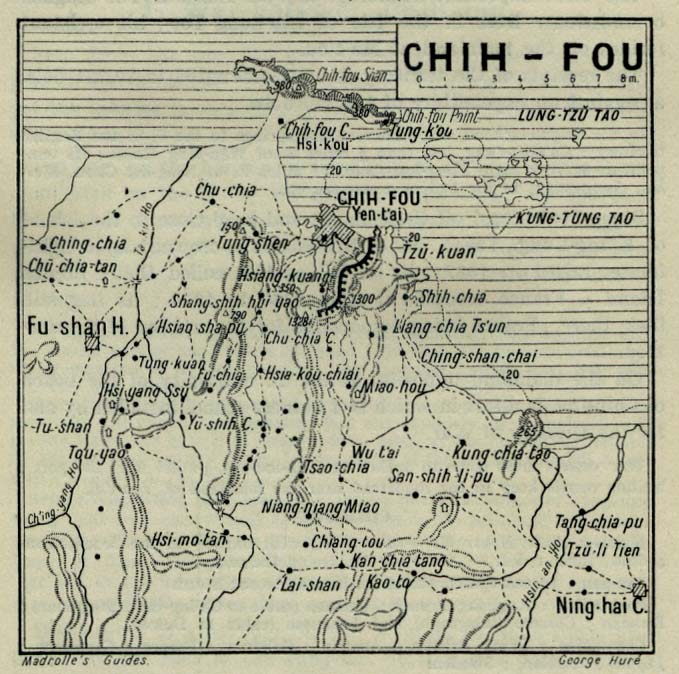 (Old 1912 map of Chefoo (Yantai)
(Old 1912 map of Chefoo (Yantai)
Occupation of Chefoo (Yantai) - 1938
© 2012 Bob Hackett, Sander Kingsepp and Anthony Tully
Chefoo (now Yantai), a large fishing seaport, is located on the southern coast
of the Bohai Sea in Chinaís northeastern Shantung (Shandong) Province. Chefoo
borders Tsingtao (Qingdao) to the southwest and Weihai to the east. The city was
known in the West as Chefoo, which actually refers to nearby Zhifu Island.
June 1858:
Tianjin (Tientsin). The "Treaty of Tien-tsin" is signed by
the defeated Qing Dynasty and the Second French Empire, Great Britain, the
Russian Empire and the United States. thus ending the first part of the Second
Opium War (Arrow War). The treaty opens more Chinese ports to the foreigners
including Chefoo.
22 August 1861:
Chefoo is officially designated an international
trading port. Seventeen nations, including Britain, establish consulates in
Chefoo. Among those nations are France, Great Britain, Germany, Belgium, Japan,
Russia, Sweden and the United States.
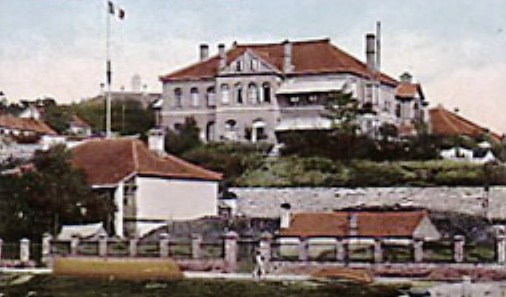 (French Consulate at Chefoo
(French Consulate at Chefoo
1891-1898:
The Qing government begins to improve Tsingtao's existing fortifications against naval attack. In 1897, German troops seize Tsingtao. In 1898, China concedes the Shantung area to Germany including Chefoo.
1917:
China enters World War I on the side of the Allied Triple Entente with the condition that all German Shantung will be returned to China.
28 June 1919: The Treaty of Versailles:
After the defeat of Germany, Japan is given a mandate over the ex-German colonies in the Pacific with the exception of Tsingtao, although they regain their leasehold there. Despite China's agreement with the Allied Triple Entente, the Treaty of Versailles transfers German concessions in Shantung, including Chefoo and Tsingtao, to Japan rather than returning sovereign authority to China.
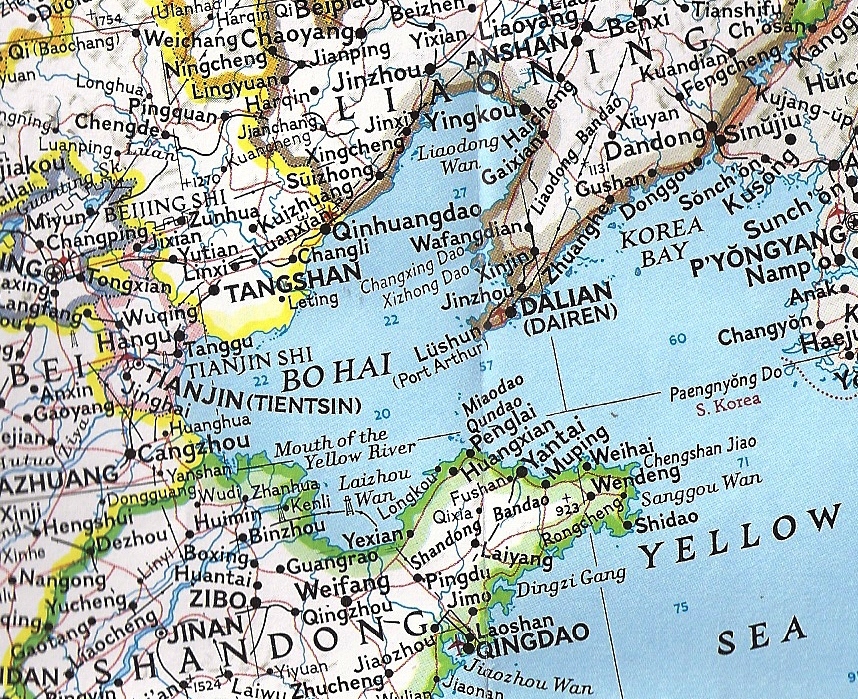 (Modern map showing Chefoo (Yantai), Tsingtao (Qingdao) and Tientsin (Tianjin)
(Modern map showing Chefoo (Yantai), Tsingtao (Qingdao) and Tientsin (Tianjin)
1919-1941:
Between the World Wars, Chefoo is a summer station for the United States Asiatic Fleet. While at Chefoo, the Navy rents nearby small Kentucky Island to allow the entire Fleet Marine Force an opportunity to maintain their field skill proficiency for weeks at a time.
1 September 1931:
Admiral Charles B. McVay (USNA 1890) is relieved of command of the United States Asiatic Fleet (USAF) by classmate Vice Admiral (later Admiral) Montgomery M. Taylor (USNA 1890). USS HOUSTON (CA-30) is flagship of the fleet. [1]
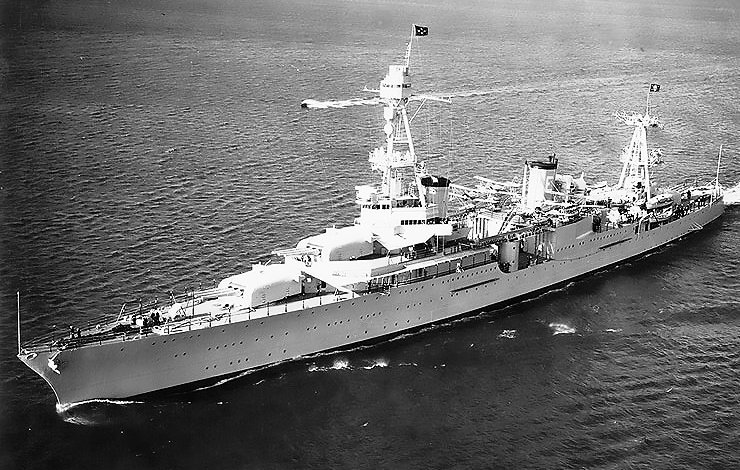 (USS HOUSTON in 1935)
(USS HOUSTON in 1935)
During the Fall, USAF destroyers based at Chefoo and submarines based Tsingtao hold exercises, then proceed to the Manila, Philippines area. One DesDiv remains in Chinese waters, while the other destroyers are in the Philippines. Aircraft tender USS JASON (AV-2) and aircraft also operate in the Chefoo and Tsingtao areas during this period, then proceed to the Manila area. Political unrest in China calls for constant vigilance by the Asiatic Fleet to protect American lives and property. Gunboat USS TULSA (PG-22), later relieved by gunboat ASHEVILLE (PG-21), remains in the Tientsin-Taku-Chefoo area throughout the year.
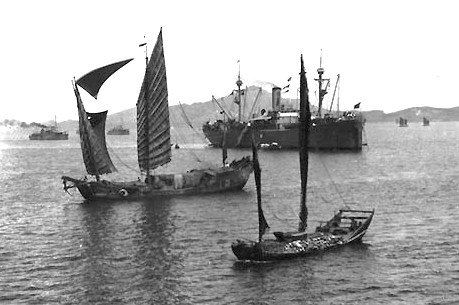
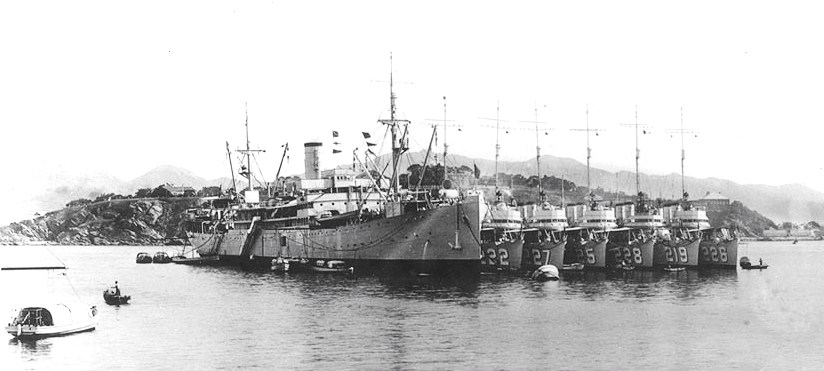
(USS BLACK HAWK (AD-9), Chefoo, 1923 and BLACK HAWK with USS BULMER (DD-222), PILLSBURY (DD-227), POPE (DD-225), JOHN D. FORD (DD-228), EDSALL (DD-219), and PEARY (DD-226) alongside, Chefoo 1930s)
25 July 1937:
The United States Asiatic Fleet's (USAF) DesRon 29's USS PAUL JONES (DD-230)(F), ALDEN (DD-211), WHIPPLE (DD-217) and BARKER (DD-213) depart Chefoo and rendezvous with CinC, USAF, Admiral Harry E. Yarnell's (USNA 1899) (former CO of SARATOGA, CV-3) flagship, AUGUSTA (CA-31) enroute to Vladivostok, Siberia, USSR. The ships arrive there the morning of 28 July and remain until the afternoon of 1 August when the destroyers depart for Chefoo and AUGUSTA for Tsingtao. [2]
2 February 1938: Operation "C" - The Occupation of Chefoo:
IJN SubRon 3's flagship, light cruiser KUMA, is tasked with putting ashore 284 men of the No. 1 Yokosuka Special Naval Landing Force (SNLF) at Chefoo. Unexpected resistance leads to later deployment of Rear Admiral (later Vice Admiral) Shishido Yoshinobu's (37)(former CO of ONDO) 1st Combined SNLF (No. 5 and No. 6 Sasebo SNLFs).
3 February 1938:
IJN submarines I-21 and I-22 are assigned to provide distant cover for KUMA, but as a result of problems with their diesel engines, neither submarine is able to sortie from Tsingtao. Nevertheless, IJN gunboats enter Chefoo's harbor and the city is captured that day. Soon, sandbag pillboxes are erected on the streets, beach and hilltops. Truckloads of Japanese troops pursue Chinese guerrillas into the mountains.
Mid-1938:
The United States Asiatic Fleet continues its mission of observing the conflict and stands ready to evacuate Americans from Chinese ports should the occasion arise. After the war moves inland and up the Yangtze, the Fleet resumes its former routine. Resident British and Americans at Chefoo are considered 'neutrals' until 8 December 1941.
Authors' Note:
[1] Admiral McVay's son, Captain (later Rear Admiral-Ret) Charles B. McVay, III, was commanding officer of USS INDIANAPOLIS (CA-35) sunk on 30 July 1945 by IJN submarine I-58 with the loss of 879 of her crew of 1,196 men; the worst disaster at sea for the USN during World War II.
[2] In February 1932, Yarnell commanded carriers LEXINGTON (CV-2) and SARATOGA (CV-3) in an exercise to test Hawaii 's vulnerability to naval air power. Yarnellís carriers proceeded to the north of Hawaii and, with a storm as cover, at dawn on Sunday, 7 February 1932, his 152 planes attacked the harbor from the NE, just as the Japanese would ten years later. The army airfields were first put out of commission after which battleship row was attacked - with simulated multiple hits on Navy ships. No defending aircraft were able to launch. Even after 24 hours of searching, Pearl Harborís defenders were unable to find the attacking carriers. Later, Admiral Yarnell strenuously warned of the Japanese threat to Hawaii, but institutions learn slowly. It often takes catastrophic events to alter established doctrine and the older the institution, the longer the learning period. In this case, the Navyís battleship admirals voted against a reassessment of naval tactics.
-Bob Hackett, Sander Kingsepp and Anthony Tully
Back to Rising
Storm Page










